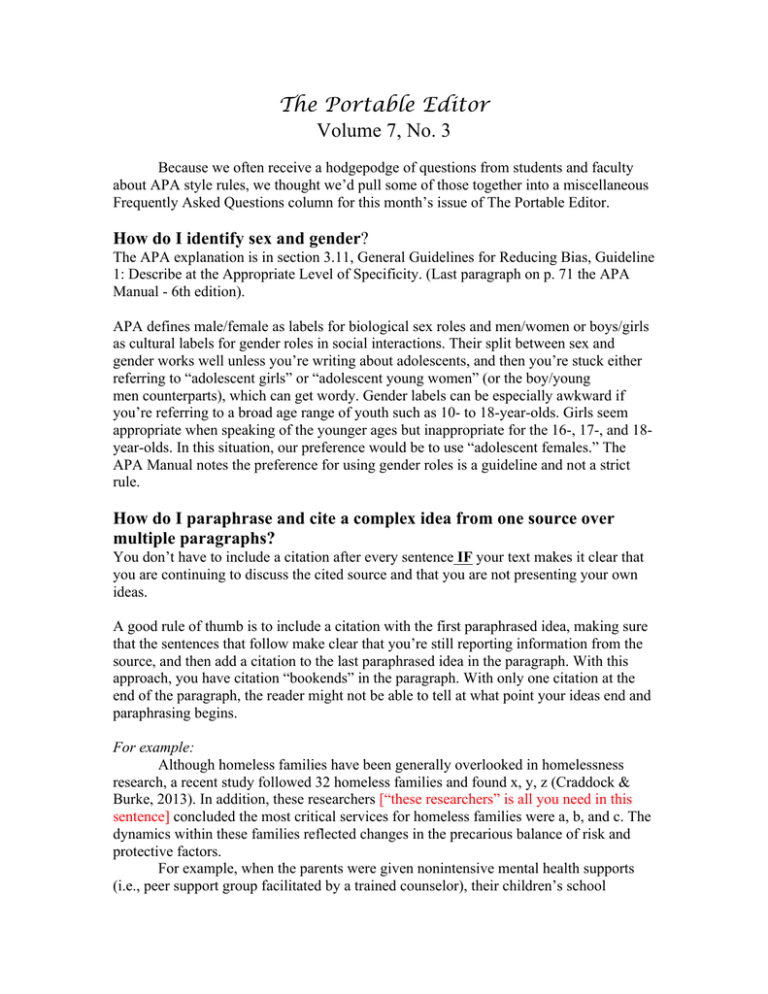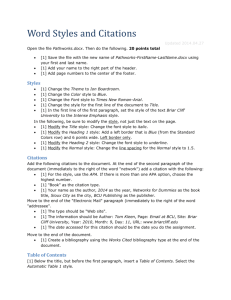The Portable Editor Volume 7, No. 3
advertisement

The Portable Editor Volume 7, No. 3 Because we often receive a hodgepodge of questions from students and faculty about APA style rules, we thought we’d pull some of those together into a miscellaneous Frequently Asked Questions column for this month’s issue of The Portable Editor. How do I identify sex and gender? The APA explanation is in section 3.11, General Guidelines for Reducing Bias, Guideline 1: Describe at the Appropriate Level of Specificity. (Last paragraph on p. 71 the APA Manual - 6th edition). APA defines male/female as labels for biological sex roles and men/women or boys/girls as cultural labels for gender roles in social interactions. Their split between sex and gender works well unless you’re writing about adolescents, and then you’re stuck either referring to “adolescent girls” or “adolescent young women” (or the boy/young men counterparts), which can get wordy. Gender labels can be especially awkward if you’re referring to a broad age range of youth such as 10- to 18-year-olds. Girls seem appropriate when speaking of the younger ages but inappropriate for the 16-, 17-, and 18year-olds. In this situation, our preference would be to use “adolescent females.” The APA Manual notes the preference for using gender roles is a guideline and not a strict rule. How do I paraphrase and cite a complex idea from one source over multiple paragraphs? You don’t have to include a citation after every sentence IF your text makes it clear that you are continuing to discuss the cited source and that you are not presenting your own ideas. A good rule of thumb is to include a citation with the first paraphrased idea, making sure that the sentences that follow make clear that you’re still reporting information from the source, and then add a citation to the last paraphrased idea in the paragraph. With this approach, you have citation “bookends” in the paragraph. With only one citation at the end of the paragraph, the reader might not be able to tell at what point your ideas end and paraphrasing begins. For example: Although homeless families have been generally overlooked in homelessness research, a recent study followed 32 homeless families and found x, y, z (Craddock & Burke, 2013). In addition, these researchers [“these researchers” is all you need in this sentence] concluded the most critical services for homeless families were a, b, and c. The dynamics within these families reflected changes in the precarious balance of risk and protective factors. For example, when the parents were given nonintensive mental health supports (i.e., peer support group facilitated by a trained counselor), their children’s school attendance improved, with an average of a 25% reduction in missed school days (Craddock & Burke). [Citation added here because you are using stats from the source – Note repeated citations within the SAME paragraph can drop year]. However, seemingly small setbacks such as the loss of an important item (e.g., cell phone, hot plate, flashlight) had a ripple effect throughout the family that was demonstrated through reports of more frequent arguments and higher levels of depression. Overall, this study concluded that policy changes were needed to ….. Moreover, the cost-benefit of such policy changes could not only reduce public spending on piecemeal supports for homeless families but also reduce future costs by providing early intervention with the children of these families (Craddock & Burke). [Citation added for this line because it is important to be clear that the cost-savings idea came from the source and not the paper’s author]. How do I cite online training? For example, you completed the following online course: Military Sexual Trauma: Responding to Active-Duty Service Members and Veterans. The presenter for the course was Terri Spahr Nelson. The course does not include a date. The reference entry would look as follows: Nelson, T.S. (n.d.). Military sexual trauma: Responding to active- duty service members and veterans [Online training]. Retrieved from National Association of Social Workers website: http//: give exact URL if the public can access the course. If restricted to NASW members, give URL for online training information page on website. Note this format is used (rather than the more familiar “Retrieved from…”) when the author or presenter might be affiliated with the organization that has posted the source. The n.d. indicates "no date." In-text citation would be: (Nelson, n.d.) How do I cite a movie? In text: Use a signal phrase including the release (publication) date: "In the movie Fried Green Tomatoes directed by Jon Avnet (1991), the struggles of …” OR If quoting the movie, “In Fried Green Tomatoes (Avnet, 1991), the character Sipsey sums up the secret of life by saying, “The secret is in the sauce.” In References: List the producer and/or director and as much location contact information as available. Some examples: Avnet, J. (1991). Fried green tomatoes [Motion picture]. United States. Paramount Pictures. OR Scorsese, M. (Producer), & Lonergan, K. (Writer/Director). (2000). You can count on me [Motion picture]. Universal City, CA: MCA Universal Studios. The Reference form also depends on the format in which you viewed the movie: Avnet, J. (1991). Fried green tomatoes [DVD]. United States. Paramount Pictures Home Video. Stone, O. (Producer/Director). (1986). Platoon [VHS tape]. Burbank, CA: Metro Goldwyn Mayer. Need One-­‐on-­‐One Writing Support? Please email to schedule an appointment: soswwritingsupport@gmail.com

